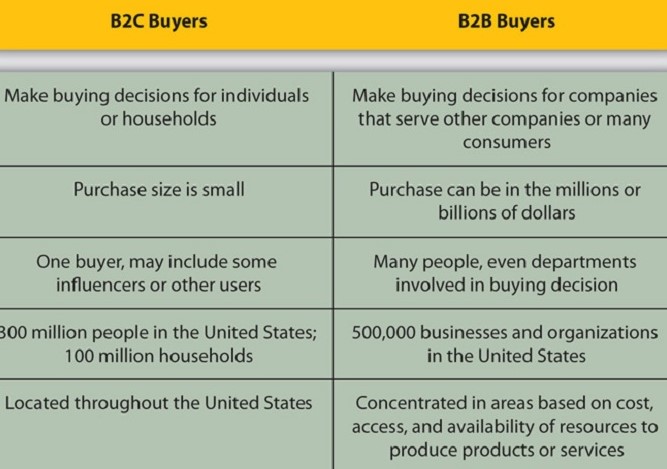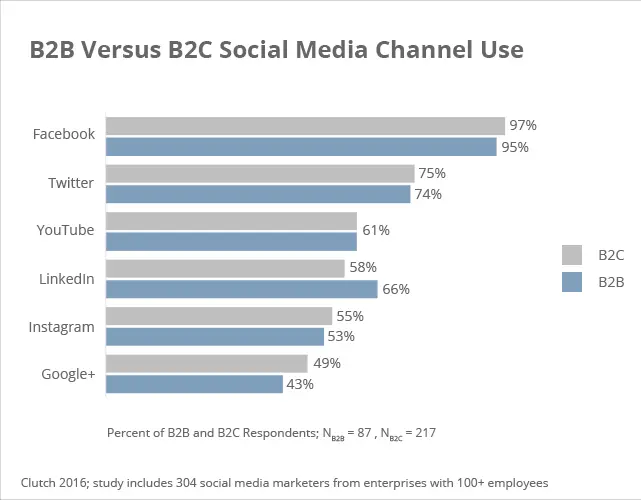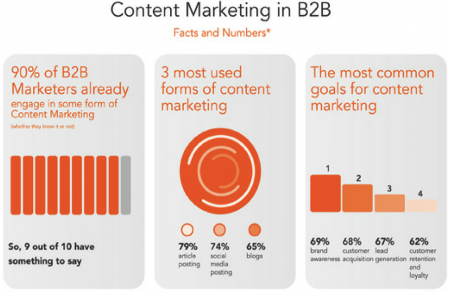What's the distinction between B2B and B2C for paid social media?
The terms B2B (business-to-business) marketing and B2C (business-to-consumer) marketing sound similar, but they differ significantly in practice, especially when it comes to paid social media.
Areas like content, goals, best practices, and which platforms to use can affect the most effective strategies in paid social media. This table shows some of the main differences.

These differences are particularly evident in the approaches to paid social media strategies. Before we get into the different strategies, let's take a closer look at the differences between B2B and B2C.
What is B2B Paid Social Media?
B2B buyers are usually large organizations (such as corporations, hospitals, or universities) that market their products or services to other companies. These companies typically require multiple stakeholder approval before making a purchase, which often increases the length of the sales cycle.
When conducting B2B marketing, the message should focus on logic and ROI rather than emotional impact. How can you help your organization achieve its goals? What is important for the mission of your organization?
When creating a B2B paid social marketing strategy, make sure that your campaigns and collateral have a solid return on investment (ROI) that highlights how your product or service is helping them save time, money, or both.
What is B2C Paid Social Media?
Conversely, B2C marketing means that you are marketing directly to a consumer. The focus should be on the benefits of the product – and how that product can benefit the consumer. However, the purchase decision is based much more on emotions than on a tangible ROI.
Buyers don't want to put in extra work to understand the value of your product. You must clearly state the benefits in a concise manner that harnesses an emotional pull.
B2C and B2B also differ in the length of the buying process, with consumers making purchases in minutes to days. In contrast, B2B consumers take much longer, with the decision-making process occasionally taking a year or more.
B2B vs. B2C marketing on social platforms
In addition to the above differences, B2B and B2C users typically use different social platforms. This distinction is important to marketers as it tells where to focus your time and resources targeting these consumers.
If you're trying to sell to a consumer on a historically business-intensive platform (like LinkedIn), you're unlikely to see much success.
Use of the B2B social platform
In the past, social media platforms were not particularly powerful for B2Bs. For example, if you're trying to sell a business software solution on Facebook, you might not get very far.
Despite this precedent, there is an exception to every rule, and in this case that exception is LinkedIn.
Since the platform's launch, marketers have sought to leverage LinkedIn's ability to connect with high-performing decision makers in a professional setting.
Now you can. With 97 percent of a company's social media leads, LinkedIn is the platform every B2B marketer should be using to reach their audiences and generate leads.
That might sound easier said than done, but luckily, there are several strategies you can use to make LinkedIn your personal lead generation engine.
While LinkedIn is undoubtedly the most popular B2B platform, Twitter and Facebook take second and third place in the hierarchy.
Twitter may not be your first stop for B2B marketing, but the platform is filled with potential consumers ready to buy. In fact, 53 percent of Twitter users are likely the first to buy new products.
Twitter can help B2B marketers:
- Build brand awareness
- Improve social surveillance
- Evaluation of the competitor analyzes
Taken together, these three benefits will help increase your brand's visibility, but you can also dig deep into competitor performance and evaluate metrics like follower growth, impressions, and mentions to know where your competition is doing.
While the use of Facebook is decreasing among younger users, many B2B decision makers regularly use the social networking website. A recent study found that 74 percent of users use Facebook for work.
Facebook can help you gain access to new prospects who would never set foot on LinkedIn virtually.
Would you like more evidence that Facebook is beneficial for the B2B marketer?
With Facebook Ads, you can:
- Align your target audience with detailed settings
- Collect prospect information
- Use similar audiences to target users who are similar to your best customers
- Retarget users who have already interacted with your brand
Moral of the story: If you're considering removing Facebook from your B2B marketing strategy, don't.
Use of the social B2C platform
While savvy marketers flock to LinkedIn, Facebook, and Twitter to reach B2B consumers, marketers targeting B2C consumers need to adapt their target platforms accordingly. Let's take a look at some of the most popular platforms for B2C marketing.
Instagram was once dismissed as too young to waste marketing spend. Today, however, the platform is a dream come true for marketers and offers tons of opportunities to reach established and new consumers.
Given the brevity of the B2C sales cycle, Instagram is the perfect couple for business-to-consumer marketing. For marketers who want to quickly fall back on visually appealing products, Instagram is the social platform.
Aside from the graphics, Instagram is also heavily used by active consumers.
The Instagram business portal reports:
- 60 percent of people say they discover new products on Instagram.
- Over 200 million Instagram users visit at least one company profile per day.
- 1/3 of the most viewed stories come from companies.
In these stats, every marketer should sprint for their phone to launch an Instagram campaign.
Tick tock
TikTok doesn't seem like the ideal platform for your B2C marketing campaign, but many brands have had success on the interactive platform.
With the average user spending 52 minutes on the app every day, marketers have unlimited opportunities to reach their desired audience.
Unlike other social platforms, TikTok offers marketers a variety of unique advertising opportunities including:
- In-feed videos
- Influencer packages
- sponsored AR content
As the fastest growing social platform out there, take advantage of the huge audience that is just a video away.

B2B vs. B2C: content for paid social media
Now that you've identified the social platforms that are best for your paid social campaign, it's time to decide what type of content to share. B2B and B2C differ in this area too, with B2Bs historically performing well with an informative approach while B2Cs succeeding with a more approachable and entertaining tone.
B2B social marketing content
As mentioned above, companies buy for a well-defined reason – based on statistics, not emotions. To successfully market to B2Bs, deliver content that is focused on ROI. Below are some types of content that perform well in B2B paid social campaigns.
Information content
To demonstrate this ROI, create a library of consumable information to educate you. Some media that traditionally perform well for B2Bs are:
By showing clear value in these parts, you can scratch that ROI itch and start moving your B2B prospects through your marketing funnel.
Answer industry questions
Filling in gaps in industry content not only allows you to position yourself as the undeniable field expert, it also helps you create content that satisfies certain long-tail searches. Targeting these queries directs qualified traffic to your website, which ideally results in conversions.

B2C social marketing content
While the B2C counterpart calls for ROI data, B2C consumers are more emotional buyers. To use this motivator, use content that inspires, pleases, or evokes another positive emotion.
Tell stories
Your goal is to inspire and motivate your B2C buyers. Use storytelling to grab and keep consumers interested. Telling a story (either in a single iteration or over the life of your campaign) can attract consumers while humanizing your brand.
Visual content
Visual content captures and holds attention much more effectively than text. When you incorporate graphics into your campaigns, you're more likely to trigger an emotional response that will result in a B2C consumer making a purchase or mentally using your product as a bookmark for future reference.
B2B vs. B2C: Targets for Paid Social Media Campaigns
Given the differences in content, sales cycle, and preferred platform, it's no surprise that B2B and B2C also differ in terms of goals for paid social campaigns. Understanding the various goals provides the information you need to design successful social media campaigns.
B2B goals
Most B2B marketing campaigns aren't just aimed at making sales. Rather, a B2B marketing campaign is marked as successful when it improves:
- Brand growth
- Brand awareness
- Lead generation
- Industry expert status
Because the sales cycle for B2B customers is so long, factors like brand growth and brand awareness are incredibly valuable as they can be used to build connections with potential buyers.
B2C goals
While B2B marketers find measures of success for growth, B2C markets tend to place emphasis on direct sales and interactive metrics that display content that is of interest to users. Popular goals for B2C social campaigns are:
- engagement
- Likes
- follows
- Go viral
For the B2C marketer, these interactions mean that consumers are drawn to the brand's offerings and ready to interact with the company.
B2B vs. B2C: Best Practices for a Paid Social Strategy
While some best practices for B2B and B2C paid social marketing are general, some are particularly relevant to any audience.
B2B best practices
Follow these four approaches to deliver successful B2B campaigns to aid you in your planning phase.
Use multiple channels
Multichannel campaigns increase ROI by 24 percent, while revenue is reduced by 9.5 percent and costs per lead by 7.5 percent. You can't just ignore this ROI.
Identify goals
Goals only work as hard as you do. You need to set achievable benchmarks for each campaign so that you can note successes and adjust errors.
Measure results
Without measurement results, how do you know whether your campaign was successful? By breaking down marketing metrics, you get specific insights into performance, identify strengths, and recalibrate weaknesses.
Deliver high quality content
They are only as good as your content. If you don't create high quality products that give your B2B customers a clear, tangible ROI, you won't see results.
B2C best practices
Are you looking for a list of B2C best practices to get your next campaign off the ground? These three tips can help.
Track the right engagement metrics
As a marketer, B2C goals depend heavily on engagement. Hence, tracking these metrics should be high on your list of must-dos.
- Commitment to social platforms
- Website traffic
- ROI
- Quality of leads
- Customer loyalty
- Exchange rate
Test your ads
Testing your ads on social platforms is a great way to see which ads are performing well on your target audience. This helps to limit spending and increase audience engagement. A / B testing is a particularly effective way to better understand which ads customers like.
Clearly identify your target group
Without clearly defining your target audience, you cannot market effectively on social media. By finding out who and why you can target the audience most likely to engage with your content or buy your product.
Conclusion
Regardless of whether you are marketing to a B2B or B2C audience, it's important to understand the differences between the two audiences so that you can create a campaign that will actually convert.
When creating paid social campaigns, focus on identifying content that is best for your audience and use the platform that your audience is most active on.
By giving your consumers what they want, when they want, where they want it, you achieve every marketer's goal: increased visibility.
What is the biggest difference between B2B and B2C audiences?

See How my agency can drive Firmly Traffic volumes on your website
- SEO – Unlock tons of SEO traffic. See real results.
- Content Marketing – Our team creates epic content that is shared, links accessed and visitors drawn.
- Paid media – effective paid strategies with a clear ROI.
Book a call
